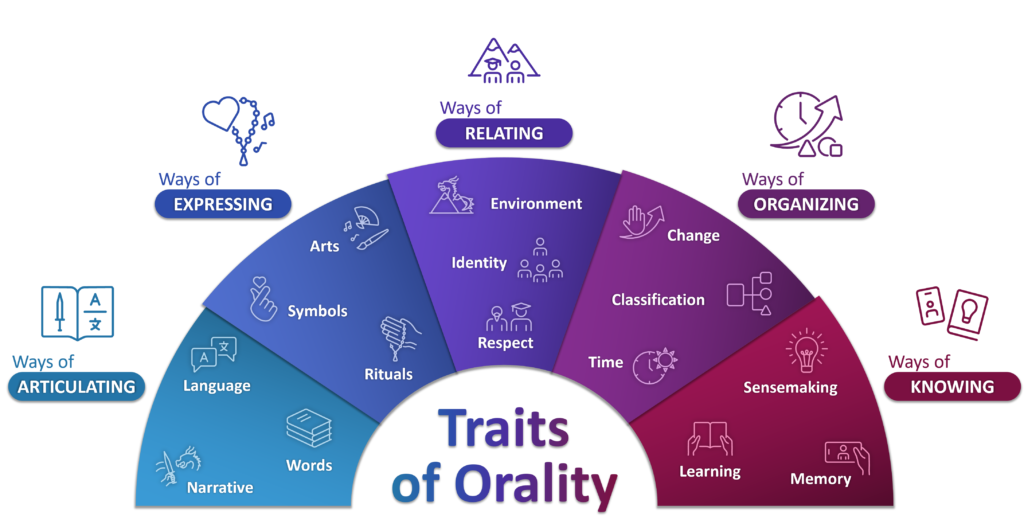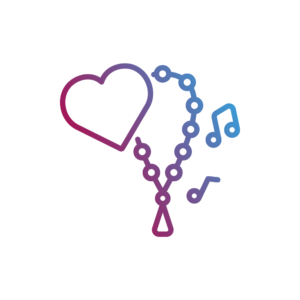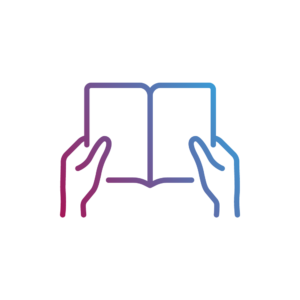ORALITY
Heart and mind communicated with all senses.
It simply is the ways and means of communicating orally with either a preference over textuality (print) or to the exclusion of it. For purposes of mission, orality can be defined as “a complex of how oral cultures best receive, understand, remember, and pass on news, important information, and truths.”1
Oral people are not to be equated with illiterate. Instead of using a dichotomy of orality and textuality, we see it as a continuum between two poles. People who mostly rely on written text are LOR, and people who prefer to communicate with oral methods are HOR. Most people will not be on one extreme but rather somewhere in between.
This survey was developed to quantify people’s orality preferences. We described 15 traits of orality in 5 clusters. From there, a series of questions help to access people groups, resulting in an overall Orality Quotient (OQ) and an OQ for each of the 5 clusters.
Based on the OQ, recommendations are given for instructional design, discipleship, or evangelism based on the 7 disciplines of orality used by Jesus in his ministry.
Historical development of textuality

When the Bible came off Gutenberg’s printing press about 500 years ago, he didn’t know that his invention would forever change the world. For the first time in history, the written page was within reach of the illiterate masses and even fueled the Protestant Reformation. Truth and information that previously came from the mouths of sages and songs were now stored and studied in books and libraries. Before, everyone was highly reliant on oral communication. Now, the West took a new path. The path of reading, writing, and reasoning. Western colonial powers capitalized on this new path and rapidly advanced it through education, industry, and scientific discoveries.
As Colonial powers gobbled up the planet’s resources, the Good News also reached every part of the world where Christ was unknown. Western missionaries built hospitals, churches, and schools as they passed on the Good News using the same methods they used to learn it – reading & writing. After Euro-Christians developed 2-300 years of, they expected those whom they called “savages” in the tribes of Africa, Asia, and South America to convert to the church through Western thinking and Western forms of Christianity. Converts were pressured to dress like the West, talk, learn, sing, and lead with Western innovations. They were “converts to Christianity” but never fully understood the Kingdom of God and His church.
The oral majority today
80% of the world is highly reliant on oral communication.2 That is 8 out of every 10 people! It’s not that they can’t read or write. It simply means they prefer to communicate and learn through things like music, arts, and drama from people they trust in they understand and with terms they use. It’s how they best receive, understand, remember, and pass on news, important information, and truths. The COVID-19 pandemic significantly lessened the children’s reading comprehension even further.3

Today the dominant Western thinking – with its high reliance on text – is setting the standards in education worldwide. By doing so, oral cultures are “forced” to discard their own way of thinking and expressing themselves. The divide between higher orality and lower orality-reliant people is not clear-cut, but rather a preference spectrum that ranges from very high to very.
The 15 Traits of Orality
Andy: Do you like chicken?
Susan: Sure, I love to eat chicken!
Andy now knows that Susan loves chicken. Still, there are hundreds of chicken recipes out there, and Andy could still get it wrong if he had to cook for Susan.
Then we talk about a people group’s orality; we only have a general idea about how they are. Orality comes in different flavors, and we must look deeper than just thinking that storytelling will be a good method to reach them. The traits of orality help us understand a people’s orality reliance in more detail.
The word “traits” is typically used to refer to distinguishing qualities, characteristics, or features that define or describe someone or something. It is often used to describe individual attributes, behaviors, or patterns of thought that are considered typical or distinctive of a person, animal, or object. In this sense, we ask: What traits are common for oral-preference learners or oral cultures?

During our study of oral cultures, we identified 15 traits of orality. To make these easier to understand, we’ve grouped them into 5 clusters. While these categories are based on Walter Ong’s psychodynamics of orality,4 we’ve also included additional research from scholars like Geert Hofstede5 to create a more comprehensive picture.
We recognize that there is some overlap between these traits and that they could fit into multiple clusters. Our goal in categorizing them is to provide a valuable framework for our survey, but we acknowledge that there are other ways of understanding orality. Ultimately, we hope this framework will help us better understand the unique qualities of oral cultures and how they shape communication and interaction.
Take the survey and learn more about the traits of orality of your people group.
The 5 Clusters
- Ways of ArticulatingThe orality traits linked to language, narrative, and words that help people articulate the things around us so that we gain a shared understanding. People tend to think more generally/descriptively on one side of the lingual spectrum. On the other side of the spectrum, people…
- Ways of ExpressingHow we display our inner speech through arts, rituals, and symbols. They generate the power to penetrate the heart and transform the mind by engaging all senses. On one end of the spectrum, people generally tend to immerse themselves in the medium of their own…
- Ways of RelatingThe orality traits of identity, respect, and environment describe our connectedness within our world and community. People generally function more holistically on one side of the spectrum – they are a part of the whole. On the other side of the spectrum, people tend to…
- Ways of OrganizingThe traits that describe our sense of time, need for change, and how we classify things in our world. They represent how we tend to frame and manage the patterns and movement of life together. On one side of the spectrum, people generally frame things…
- Ways of KnowingThese traits require a more complex set of factors. They represent how we capture and process a message, how people really learn, and their preferred ways of remembering a message. On one side of the spectrum, people gravitate to familiar patterns, repetition, and non-linear logic.…
The 15 Traits of Orality
Ways of Articulating
- LanguageA communication system structured in vocabulary and grammar expressed through sounds, symbols, gestures, and other non-verbal cues. Language is passed…
- NarrativeThe human capacity to create and share stories of all kinds. They serve as a vehicle to receive, process, remember,…
- WordsBuilding blocks of a language describing local realities for shared understanding and expression. The evolving speech and multiple literacies bond…
Ways of Expressing
- ArtsThe innate creative capacity to express our inner speech through all our senses. Typically people think of arts by referring…
- RitualsIt encompasses several other traits of orality. They act out and convey collective meaning to successive life events (weddings, graduations).…
- SymbolsIt includes words, signs, colors, gestures, pictures, metaphors, rituals, etc., and embodies an idea, object, or relationship. Some cultures predominantly…
Ways of Relating
- EnvironmentThe sum of all the interacting living things (material and non-material) and non-living elements and how they affect human life’s…
- IdentityHow individuals or groups perceive and define themselves and others. Most clearly, it relates to how a people group looks…
- RespectIt relates to the level of admiration for others. It may be ascribed, confirmed, or earned on qualities, achievements, or…
Ways of Organizing
- ChangeHow people value innovation. That may include ideas, teachings, or technologies that affect their daily life and processes. Story: Electrifying…
- ClassificationPatterns by which we holistically structure and arrange our world. That includes our physical, mental, emotional, and spiritual realities. Story:…
- TimeThe created sequential dimension in which we experience life in the eternity of God. Story: Deal or No-deal? Tom: We…
Ways of Knowing
- LearningA pathway for people to construct knowledge, acquire skills, and develop attitudes. Learning domains include cognition, affection, and behavior leading…
- MemoryHow individuals or groups process and store information, experiences, and data (received through all senses) for future recall. Story: Living…
- SensemakingHow our brain receives and interacts with all information, stimuli, and data. We then filter and synthesize it according to…
- Charles Madinger, “A Literate’s Guide to the Oral Galaxy,” Orality Jornal 2, no. 2 (2013): 13–40. ↩︎
- Grant Lovejoy, “The Extent of Orality: The Word Become Flesh,” Orality Journal, no. The Word Become Flesh (2012): 11–40, 29. ↩︎
- “70% of 10-Year-Olds Now in Learning Poverty, Unable to Read and Understand a Simple Text,” World Bank, 2022. ↩︎
- Walter J Ong, Orality and literacy: the technologizing of the word (London: NY: Routledge, 2002), 31–55. ↩︎
- Geert Hofstede, Gert Jan Hofstede, and Michael Minkov, Cultures and Organizations: Software of the Mind; Intercultural Cooperation and Its Importance for Survival, Rev. and expanded 3. ed (New York: McGraw-Hill, 2010). ↩︎




















